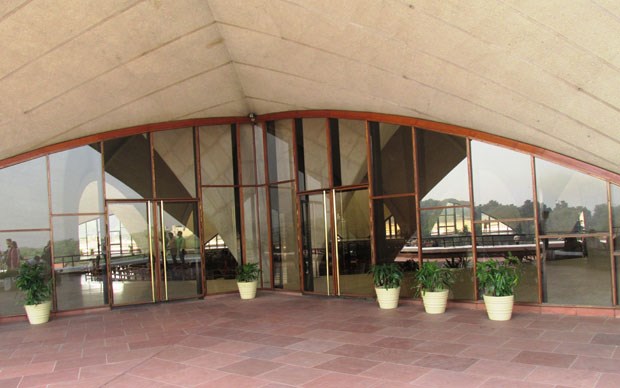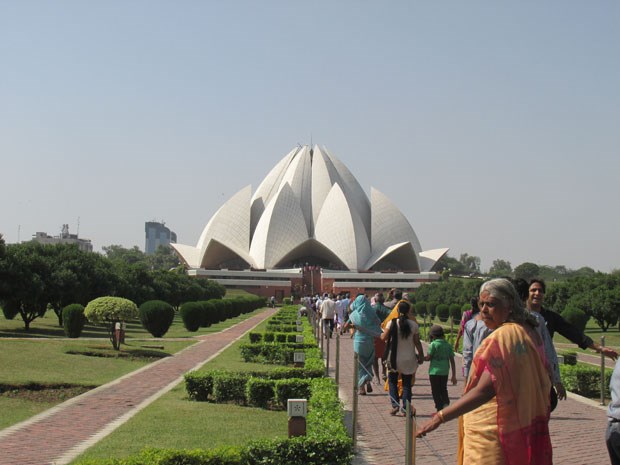Among the stereotypical images of poverty and over-crowding, India is also perceived as a deeply spiritual country. Notwithstanding this, daily life is clamorous and pressing. So it is appropriate that temples are noisy with the clang of bells, the wail of conch shells, the chanting of priests and throngs of pilgrims. Millions of people freckle the edges of rivers and lakes during religious festivals.
So where does one find that centre of meditative calm amidst all this activity? Indians seeking spiritual refreshment simply sit wherever they are and tune out, reducing their surroundings to nothing more than the hiss of ‘snow’ on a TV screen. This state of mind over matter - inner silence in the midst of chaos - is just one more anomaly in a country that is nothing else if not contradictory.
I am not adept at retreating into inner space, so after five days in Delhi, nerve ends a-quiver from the pollution, heat and crowds, I figure my soul could do with a bit of restorative therapy.
The Baha'i Temple lies on the outskirts of Delhi and despite being early November, the sun hammers down from a sky the colour of bleached khaki. I am liquefying into runnels of sweat, as the cab driver inches his way through traffic, people and animals. Yet once within the entrance gates of the temple, the outside world fades to a distant murmur. A long pathway stretches between lawns, flowerbeds and spreading trees and at the end of it, a marble building rises like a lotus, its petals unfolding to the sky.
I walk alongside mothers carrying babies athwart their hips and toddlers holding parental hands. There are teenagers in trendy kurta-pyjamas, old women with silver nose-rings and little girls, wearing pink, frilly dresses. Businessmen in cotton safari suits rub shoulders with farmers in dhotis and turbans. Foreign tourists in floppy hats and sun-shades pause to click selfies.

On the lower level of the temple, there is a display of photographs and text about the Baha’i religion. Originally founded in Persia by a mystic, Baha’u’llah, in the middle of the last century, the Baha’i suffered terrible persecution by religious fanatics, but the Faith has since spread to a world-wide community. Its principles embrace the oneness of mankind, recognises that all religions have a common foundation, strives for the elimination of prejudice and the establishment of universal harmony among all peoples of the earth. They run charitable educational and health care institutions, and revere Nature as an integral part of universal Being.
There is a spiritual significance to the fact that the temple is nine-sided, and that there are twenty-seven “petals” of marble-clad concrete. The integer nine (and its multiples) contains all numbers within it and is a symbol of oneness and unity. I sit on the steps leading to one of the surrounding pools - nine in all - where the water flows over emerald-green tiles, resembling a calyx of leaves at the base of a lotus. A breeze lilts over the water, and I am soothed by a sense of repose, the fret of the city seeming distant and trivial. Although the place is teeming with visitors, there is no bustle, just a smooth, unhurried flow of children and adults talking in low tones or, like myself, merely gazing across the waters and the gardens beyond.
With some reluctance, I move on, climbing to the upper level and the entrance to the main chamber. The interior of the hall is a sonata of architectural harmony. Marble arches, like inward curving petals reach upwards to meet at apex of the vaulting dome. Muted sunlight filters in through the surrounding glass doors and windows, and falls in triangles across the floor.
Although intended mainly as a meditation retreat, daily services are held in the Prayer Hall, but today the only activity is the shadowy movement of people coming in and leaving the chamber. Sitting in a marble backed pew, I surrender to the serenity and radiance of the hall.
When I emerge, blinking, into the brilliant sunshine, I am astonished to discover that it is now well past two in the afternoon. My taxi heads back towards the city centre - again through a confusion of traffic, heat and dust. But I am mellow now. India is India after all. Immutable.
Travel Writers’ Tales is an independent newspaper syndicate that offers professionally written travel articles to newspaper editors and publishers. To check out more, visit www.travelwriterstales.com
IF YOU GO:
For more information about the Lotus Temple and about Delhi in general go to Delhi Tourism: http://www.delhitourism.gov.in/delhitourism/aboutus/index.jsp



